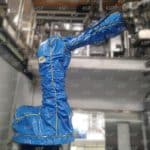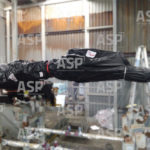With its 35 years of experience, ASP protects all known brands of robots used in various applications, including in the ceramic industry. Many of these applications generate large quantities of dust and water, exposing the rotating axes to significant stress. Therefore, a protective cover is necessary to preserve the mechanical components of the robot.
The robots commonly used in material handling applications are either 6-axis or 4-axis robots, depending on the size and weight of the parts being handled. For heavy loads, 4-axis palletizing robots such as the ABBirb660, FANUC M410, KUKA KR180, and YASKAWA MPL300 models are often utilized. These robots are specifically designed to perform material handling operations. Given the abrasive environments in which these robots operate, a complete protective cover is required, often mounted on a structure connected to axis 1.
Since these robots have specific kinematics, ASP customizes the cover to match the robot’s trajectories. To achieve this, a prototyping phase with a temporary cover is conducted to evaluate its suitability for the robot’s trajectories and morphology. If necessary, modifications can be made before manufacturing the final cover to ensure optimal functionality and usability.
For machining cells, the material handling robots used for loading/unloading parts are typically 6-axis robots such as the ABBirb2600, FANUC M10iA, KUKA KR16, and UR10. As machining centers used in the ceramic industry generate a significant amount of water and abrasive dust, ASP’s protective covers in TORTOP B+, TORCAL B+, or TPSN provide optimal protection for the robots used to handle machined parts. The sealed seams enhance the level of protection to prevent the infiltration of lubricants or chips inside the seams. Whether the cover provides full or partial protection, ASP adjusts the cover based on the areas affected by the process (e.g., wrist joint, axis 2), allowing for longer maintenance intervals, reduced repair costs, and machine downtime.










